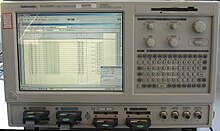Logic analyzer
A logic analyzer is an electronic measuring device that can record and display the course of digital signals over time. It is used for testing and troubleshooting digital electronic circuits, for example in the development of computers and electronic control units . Compared to oscilloscopes , logic analyzers offer significantly more inputs (typically 16 to several 100), but generally only show discrete logic values on the Y-axis. This basically includes the Boolean truth values of binary digital technology false ("0") and true ("1"). Depending on the equipment, additional values can be recognized and displayed. Examples of this are undefined voltage levels or the high-resistance state of a line ("Z" / "high impedance").
As a mixed form of logic analyzers and oscilloscopes, there are hybrid devices which, as so-called mixed-signal devices, can record continuous analog signals together with discrete digital signals and display them over the same time axis.
function
A logic analyzer can trigger on a complex sequence of digital events and then record a large amount of digital data from the monitored system. In addition, a number of models offer advanced analysis and presentation methods; so z. B. the sequence of a computer program can be displayed as with a software debugger , so in disassembled representation when the inputs are connected to the address and data bus of a microprocessor . In addition, the details and various phases of the activities on the buses mentioned can be analyzed and displayed. This is all very dependent on the particular processor model, so that it is essential for a logic analyzer that it can be adapted to a specific processor, e.g. B. by plug-in modules or adapters.
When the first logic analyzers were introduced, it was common to connect up to several hundred terminals to a digital system. Later, specialized multi-pole connectors were used for this purpose, which were already provided for when the circuit was developed.
In modern computer systems, various other tools have supplanted the logic analyzers for many purposes. Many microprocessors now have built-in hardware support for software debuggers and diagnostic interfaces (see boundary scan ), via which input / output connections and internal register structures can be assigned values (simulated input) and queried.
Most digital circuits, including and especially the internal circuits of integrated circuits , are simulated during development in order to detect defects before the circuit or chip is manufactured. In the simulation programs, displays are usually available for this purpose, which offer functions similar to independent logic analyzers.
Neither of these methods can accurately reproduce the high-speed data logging of a logic analyzer, but they cover most of the real needs for debugging digital circuitry and are usually cheaper to use.
Hardware emulator
While the logic analyzer follows what is happening in computer hardware in a purely passive manner, a hardware emulator also contains the processor part itself and is inserted into the computer hardware (usually plugged in) with it in order to analyze it even more closely, see Emulator .
Device forms
In addition to the measurement technology manufacturers of logic analyzers such as Keysight Technologies (formerly Hewlett-Packard and Agilent Technologies ), LeCroy and Tektronix, there are now some low-cost providers that are sufficient for normal laboratory requirements and cost less than a hundred euros. A standard PC serves as the display device. Due to the high transmission speed of the USB interface, scanned data is streamed directly to the PC and buffered in the abundant working memory there. The triggering usually takes place through asynchronous evaluation of the existing data record. There are also inexpensive FPGA-based analyzers that offer higher sampling rates than streaming analyzers (in return, the memory depth is often delicately limited), such as the SUMP family.

